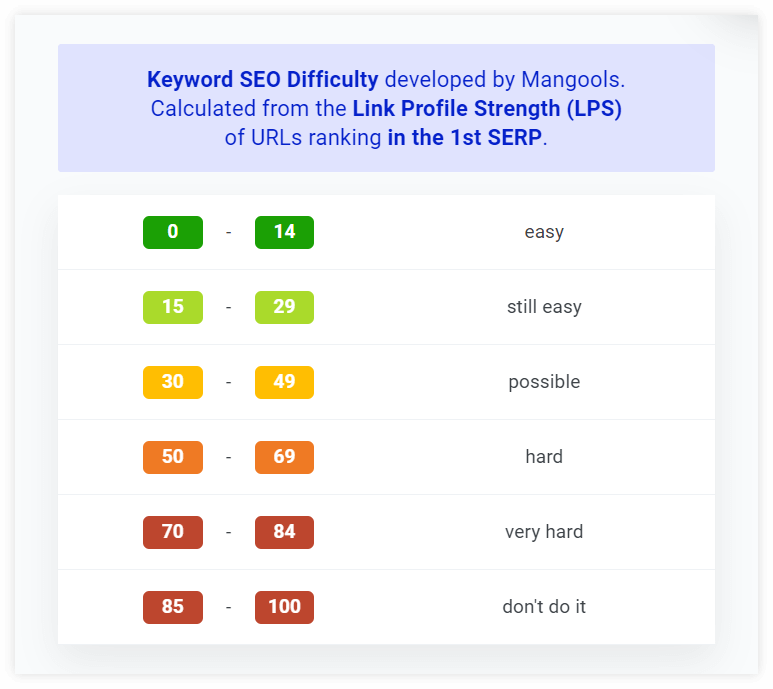Understanding keyword difficulty is crucial for SEO success. It helps in planning effective strategies.
In the world of SEO, keyword difficulty is a key metric. It indicates how hard it is to rank for a specific keyword. Knowing this can save you time and effort. It helps focus on keywords that can bring the best results.
High difficulty keywords may require more resources. Low difficulty keywords can be easier to rank for. By understanding keyword difficulty, you can optimize your content better. This knowledge can lead to more traffic and higher search rankings. Ready to dive in? Let’s explore what keyword difficulty is and why it matters for your SEO strategy.
Table of Contents
ToggleIntroduction To Keyword Difficulty
Understanding Keyword Difficulty is crucial for effective SEO strategy. It helps you know which keywords can help your website rank higher on search engines. This guide will introduce you to the concept of Keyword Difficulty and explain its significance in SEO.
What Is Keyword Difficulty?
Keyword Difficulty measures how hard it is to rank for a specific keyword. It depends on various factors like the strength of the competition, the quality of their content, and their backlink profiles.
Tools like Ahrefs, SEMrush, and Moz provide Keyword Difficulty scores. These scores help you decide which keywords to target based on your website’s authority and resources.
| Tool | Keyword Difficulty Score |
|---|---|
| Ahrefs | 0-100 |
| SEMrush | 0-100 |
| Moz | 0-100 |
Importance In Seo
The importance of Keyword Difficulty in SEO cannot be overstated. It helps you pick the right battles. Targeting high-difficulty keywords might be tough for new websites. Instead, focus on low to medium-difficulty keywords to see quicker results.
Here are some reasons why Keyword Difficulty is important:
- Resource Allocation: It helps you allocate your SEO resources more effectively.
- Strategic Planning: It aids in planning your content strategy based on achievable goals.
- Competitive Analysis: It provides insights into your competitors’ strengths and weaknesses.
Using the Keyword Difficulty metric, you can create a balanced SEO strategy. Target a mix of easy and challenging keywords to improve your site’s ranking over time.
Example:
Low Difficulty: "easy cake recipes"
Medium Difficulty: "best chocolate cake recipe"
High Difficulty: "chocolate cake"

Credit: www.wordstream.com
Measuring Keyword Difficulty
Understanding keyword difficulty is essential for effective SEO strategy. It helps in assessing the effort needed to rank for a specific keyword. By measuring keyword difficulty, you can prioritize which keywords to target. This ensures better use of resources and time.
Tools For Analysis
Several tools can help measure keyword difficulty. These tools provide insights and metrics to make informed decisions.
- Ahrefs: A popular tool for keyword analysis. It offers a keyword difficulty score based on backlink data.
- SEMrush: This tool provides a keyword difficulty percentage. It also shows competitor analysis and search volume.
- Moz: Known for its keyword explorer. It offers a difficulty score based on page authority and domain authority.
- KWFinder: A user-friendly tool. It provides keyword difficulty scores and related keyword suggestions.
Metrics To Consider
When measuring keyword difficulty, consider several important metrics. These metrics help in understanding the competitiveness of a keyword.
- Search Volume: Indicates the number of searches for a keyword. Higher search volume often means higher competition.
- Backlinks: The number of backlinks required to rank. More backlinks generally mean higher difficulty.
- Domain Authority: A measure of a website’s strength. Higher domain authority websites are tougher to outrank.
- Page Authority: Similar to domain authority but specific to individual pages. Higher page authority pages are harder to surpass.
- Content Quality: The quality and relevance of content. High-quality content is crucial for ranking.
Using these tools and metrics, you can effectively measure keyword difficulty. This helps in creating a targeted and efficient SEO strategy.
Choosing The Right Keywords
Selecting the perfect keywords is crucial for SEO success. It impacts your site’s visibility and search rankings. To achieve this, consider keyword difficulty, search volume, and relevance. Finding a balance can lead to better results.
Balancing Difficulty And Volume
Keyword difficulty measures how hard it is to rank for a keyword. High difficulty often means fierce competition. Low difficulty may indicate fewer searches. It’s essential to balance these factors.
Consider using a table to compare keywords:
| Keyword | Difficulty | Search Volume |
|---|---|---|
| Keyword A | High | Low |
| Keyword B | Medium | Medium |
| Keyword C | Low | High |
Choose keywords with medium difficulty and good volume. These offer a better chance to rank well.
Finding Long-tail Keywords
Long-tail keywords are phrases with three or more words. They have lower difficulty and more specificity. They attract targeted traffic.
Here are some tips to find long-tail keywords:
- Use keyword research tools: Tools like Google Keyword Planner help find these keywords.
- Analyze competitors: Check what long-tail keywords competitors use.
- Consider user intent: Think about what users might search for.
Long-tail keywords can drive more relevant traffic to your site.

Credit: ahrefs.com
Competitive Analysis
Understanding your keyword difficulty requires a deep dive into your competitors. This process, known as competitive analysis, helps you see who you are up against and what they are doing to rank high. In this section, we will cover the steps involved in identifying your competitors and analyzing their keywords.
Identifying Competitors
Start by identifying your main competitors. These are the websites that rank high for the keywords you are targeting. Use search engines to find these sites. Simply type in your target keyword and see who appears on the first page.
Once you have a list, it’s time to categorize them:
- Direct Competitors: Those offering similar products or services.
- Indirect Competitors: Those not offering the same products but targeting the same audience.
List down the top 5-10 competitors. This will give you a clear picture of your competition.
Analyzing Competitor Keywords
Now that you have identified your competitors, the next step is to analyze their keywords. This helps you understand what keywords they are ranking for and how difficult it is to rank for those keywords.
Use tools like Ahrefs or SEMrush to gather this data. These tools provide detailed insights into the keywords your competitors are using. Look for:
- Primary Keywords: The main keywords that drive traffic to their site.
- Long-Tail Keywords: Less competitive, more specific keywords.
Here’s a simple table to organize your findings:
| Competitor | Primary Keywords | Long-Tail Keywords |
|---|---|---|
| Competitor A | Keyword 1, Keyword 2 | Long-Tail Keyword 1, Long-Tail Keyword 2 |
| Competitor B | Keyword 3, Keyword 4 | Long-Tail Keyword 3, Long-Tail Keyword 4 |
By analyzing this data, you can see which keywords are worth targeting. Focus on keywords with lower difficulty but high search volume. This will give you a better chance of ranking higher.
Content Strategy
Creating a solid content strategy is crucial for tackling keyword difficulty. High keyword difficulty means more competition. You need to plan your content to stand out. A well-thought-out strategy helps you rank higher in search results.
Creating High-quality Content
High-quality content is essential. It attracts and retains readers. Make sure your content is useful and engaging. Here are some tips:
- Understand your audience’s needs.
- Provide valuable information.
- Use clear and concise language.
- Incorporate visuals like images and videos.
Focus on creating content that answers questions. This boosts your chances of ranking higher. Use tools like Google Analytics to understand what works best.
Optimizing For Target Keywords
Optimizing for target keywords is key to overcoming keyword difficulty. Proper optimization makes your content more discoverable. Here are steps to follow:
- Identify the right keywords using tools like Ahrefs or SEMrush.
- Incorporate these keywords naturally into your content.
- Use keywords in titles, headers, and meta descriptions.
- Ensure your content answers the search intent behind the keywords.
Maintain a balance. Overusing keywords can lead to penalties. Aim for a natural flow in your writing.
Check the keyword density. Tools like Yoast SEO can help. They ensure you don’t over-optimize.
| Keyword Placement | Importance |
|---|---|
| Title | High |
| Headers | Medium |
| Content Body | High |
| Meta Description | Medium |
In summary, a well-crafted content strategy can help you overcome keyword difficulty. Focus on creating high-quality content and optimizing for target keywords. This approach will improve your search rankings and attract more readers.
On-page Seo Techniques
On-Page SEO is essential for improving your website’s ranking. It involves optimizing individual web pages to earn more relevant traffic. This includes various practices that help search engines understand your content better. Let’s explore some key on-page SEO techniques.
Using Keywords Effectively
Using keywords effectively is crucial. You must place keywords in strategic locations on your page.
- Include primary keywords in the title tag.
- Use keywords in the first 100 words of your content.
- Place keywords in your headings and subheadings.
- Spread keywords evenly throughout the content.
Remember to keep the keyword density natural. Avoid keyword stuffing as it can harm your ranking.
Improving Meta Tags
Meta tags play a significant role in on-page SEO. They help search engines understand the content of your page.
| Meta Tag | Description |
|---|---|
| Title Tag | This is the title of your page. It should be under 60 characters and include your primary keyword. |
| Meta Description | This is a brief summary of your page. It should be under 160 characters and include your primary keyword. |
Ensure your meta tags are unique for each page. They should clearly describe the content to attract users and search engines.
Off-page Seo Tactics
Understanding Keyword Difficulty is vital for successful SEO strategies. One essential aspect of improving keyword ranking is through Off-Page SEO Tactics. These tactics help build authority and trust in your website. Here, we’ll explore two main off-page SEO tactics: building quality backlinks and leveraging social media. In order to improve keyword ranking, building quality backlinks from reputable and relevant websites is essential. This not only increases your website’s credibility but also signals to search engines that your website is a trusted source. Additionally, leveraging social media to promote your content and engage with your audience can also significantly impact your website’s authority and visibility. These are top strategies to boost rankings and drive organic traffic to your site.
Building Quality Backlinks
Building quality backlinks is a critical off-page SEO tactic. Search engines see backlinks as votes of confidence. The more quality backlinks you have, the higher your site can rank.
Here are some effective ways to build quality backlinks:
- Guest posting on reputable websites
- Creating shareable content like infographics
- Engaging in industry forums and discussions
Guest posting can introduce your content to a new audience. Infographics are visually appealing and often shared widely. Industry forums can position you as an expert in your field.
Leveraging Social Media
Social media platforms are powerful tools for off-page SEO. Engaging with your audience on social media can drive traffic and enhance your online presence.
Here are some ways to leverage social media for SEO:
- Sharing blog posts and content updates
- Interacting with followers through comments and messages
- Collaborating with influencers in your niche
Sharing blog posts keeps your audience informed and engaged. Interacting with followers builds a loyal community. Collaborating with influencers expands your reach and credibility.
By focusing on these off-page SEO tactics, you can improve your keyword ranking and overall SEO performance.
Monitoring And Adjusting
Monitoring and adjusting your keyword strategy is crucial for SEO success. This process ensures that your efforts are aligned with current trends and search behaviors. You can maximize your content’s visibility by regularly reviewing and refining your approach.
Tracking Keyword Performance
To stay on top of your keyword strategy, tracking performance is essential. Use tools like Google Analytics and SEMrush to monitor how well your keywords are performing. These tools provide valuable insights into metrics such as:
- Search Volume
- Click-Through Rate (CTR)
- Conversion Rate
- Average Position
Regularly check these metrics to identify which keywords are driving traffic and conversions. If a keyword is underperforming, consider adjusting your content or strategy.
Adapting Your Strategy
Adapting your strategy based on performance data is essential. Here are some steps to consider:
- Identify Underperforming Keywords: Use your tracking tools to find keywords that are not meeting expectations.
- Analyze Competitors: Look at what keywords your competitors are ranking for and how they are using them.
- Content Optimization: Update your content to better match user intent or improve keyword usage.
- Explore New Keywords: Use keyword research tools to find new opportunities that align with your goals.
By continuously adapting your strategy, you can improve your site’s visibility and relevance.
Future Trends In Keyword Strategy
As we move forward into the digital age, understanding keyword difficulty becomes crucial. Future trends in keyword strategy are evolving rapidly. Businesses need to adapt to these changes. Below, we explore two key trends that will shape keyword strategies.
Voice Search Optimization
Voice search is growing. More people use devices like Alexa and Google Home. This change impacts keyword strategies. Voice searches are usually longer. They are also more conversational. For example, people might say, “What are the best Italian restaurants near me?” instead of typing “best Italian restaurants.” This affects keyword difficulty. Longer, conversational phrases are now important.
To optimize for voice search, consider these tips:
- Use natural language in your content.
- Focus on question-based keywords.
- Include long-tail keywords.
Ai And Machine Learning Impacts
Artificial intelligence (AI) and machine learning are changing SEO. These technologies analyze search patterns. They also predict trends. This affects keyword difficulty. AI helps search engines understand context better. It prioritizes content that is relevant.
Some ways AI impacts keyword strategy:
- Better keyword research tools.
- Improved content suggestions.
- Enhanced user experience.
Machine learning helps refine these processes. It ensures the most relevant content appears. This means businesses must focus on high-quality content. They must also stay updated with trends.
AI tools like Google’s RankBrain are important. They help search engines understand intent. This means your keywords must match user intent. It is not just about matching words. It is about understanding and meeting needs.

Credit: mangools.com
What are the Best SEO Strategies for Improving Search Rankings and Keyword Difficulty?
When it comes to improving search rankings and keyword difficulty, using the top strategies to improve seo is essential. This includes optimizing website content, building high-quality backlinks, and conducting keyword research to target the right audience. Implementing these strategies can help increase visibility and drive organic traffic to your site. Boosting SEO rankings can also involve improving website speed and mobile-friendliness, as search engines prioritize sites that offer a seamless user experience. Additionally, regularly updating and refreshing content on your site can signal to search engines that your site is relevant and authoritative, which can also contribute to higher rankings. By consistently implementing these strategies, businesses can see a significant improvement in their search rankings and ultimately drive more traffic to their site.
How Can Mastering SEO Strategy Help to Address SEO Performance Issues and Boost Rankings?
Mastering SEO strategy can provide top solutions to boost rankings by addressing SEO performance issues. By optimizing website content, improving meta descriptions, and utilizing relevant keywords, websites can see a significant improvement in their search engine rankings. Understanding SEO strategy is key to increasing visibility and driving more organic traffic to a website.
Frequently Asked Questions
What Is Keyword Difficulty?
Keyword difficulty measures how hard it is to rank for a keyword. It considers competition and search engine ranking factors.
How Is Keyword Difficulty Calculated?
Keyword difficulty is calculated using various metrics. These include domain authority, page authority, and competition level.
Why Is Keyword Difficulty Important?
Keyword difficulty helps in choosing the right keywords. It ensures your content can rank effectively on search engines.
What Is A Good Keyword Difficulty Score?
A good keyword difficulty score varies by niche. Generally, a score under 30 is considered achievable.
What Strategies Can Help Improve Keyword Difficulty in SEO?
When it comes to overcoming common pitfalls in seo keyword difficulty, there are a few strategies that can be helpful. Conducting thorough keyword research, focusing on long-tail keywords, and optimizing website content are all effective ways to improve keyword difficulty in SEO. These strategies can help enhance search engine rankings and drive more organic traffic to your website.
Conclusion
Understanding keyword difficulty can boost your SEO efforts. Choose keywords wisely. High competition? Try long-tail keywords. They often bring better results. Measure success with tools. Stay updated on trends. Balance difficulty with relevance. Your content should always add value. Consistent effort pays off.
Keep learning and adapting. SEO is a journey, not a sprint. With patience, you’ll see progress. Happy optimizing!








